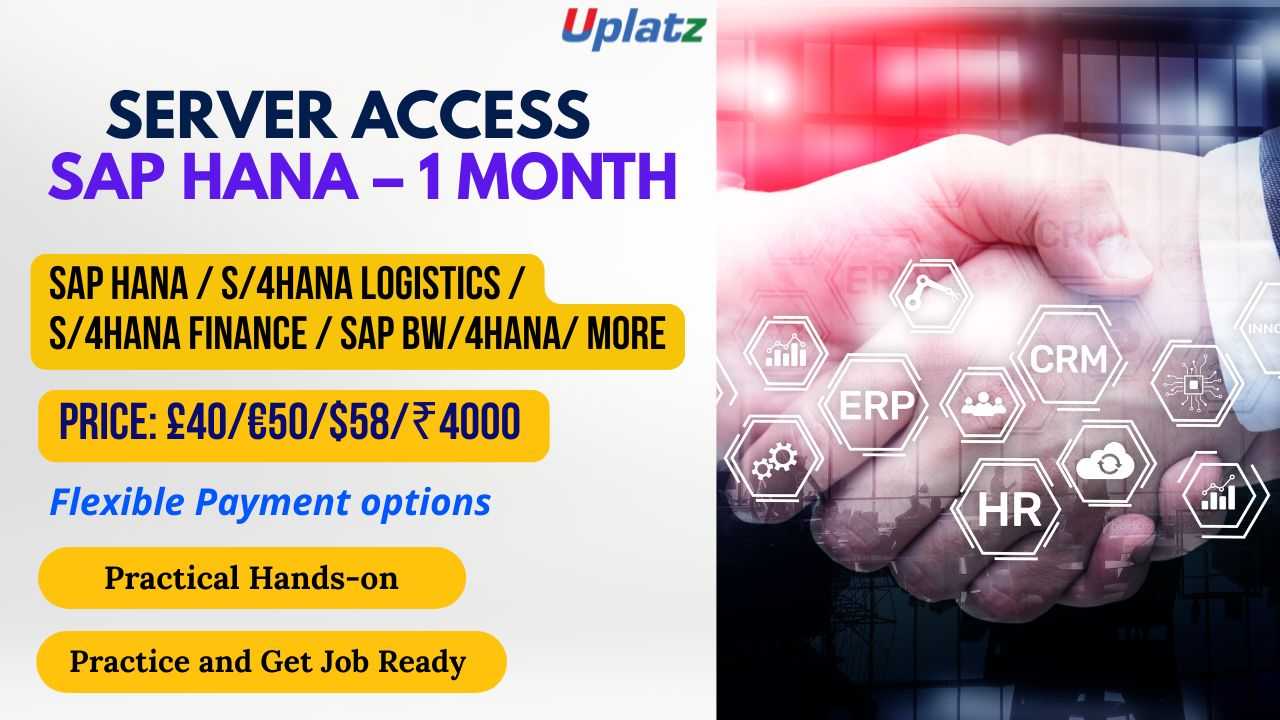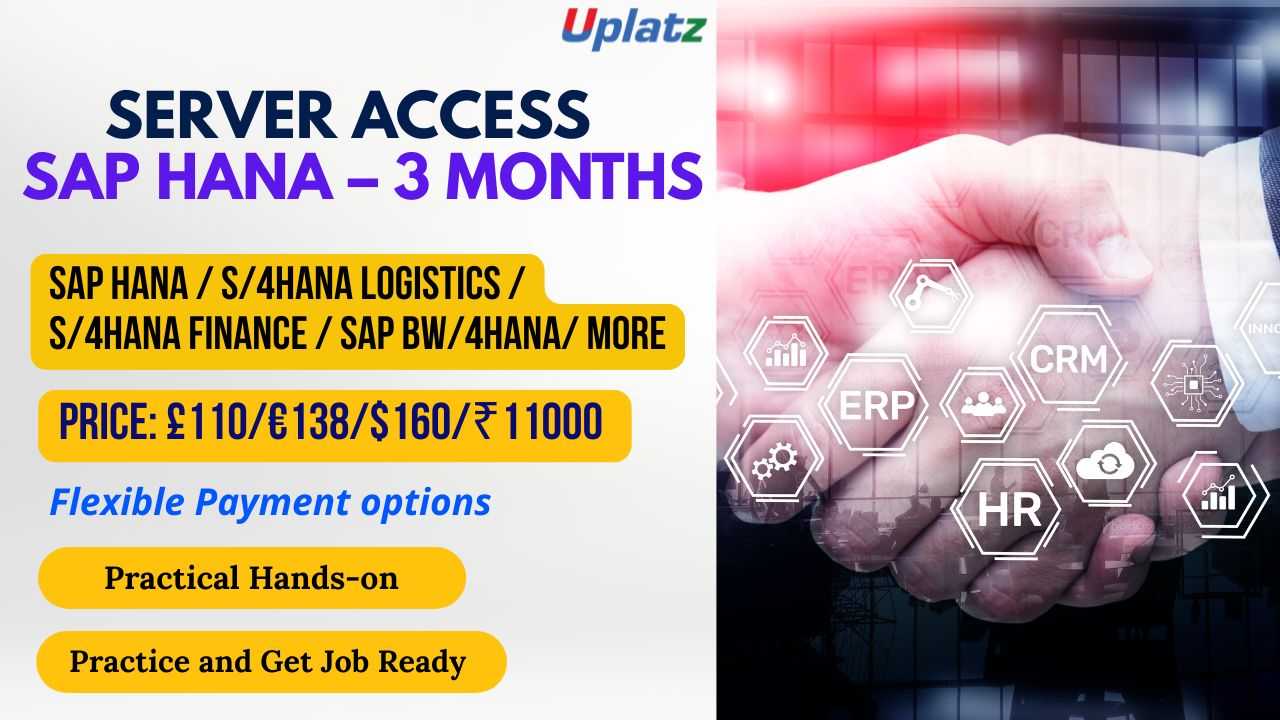Server Access - SAP HANA - 1 Month
Get 1-Month Access to SAP HANA-based Servers for Practical Learning & Hands-On Project Implementation Price Match Guarantee
Full Lifetime Access
Access on any Device
Technical Support
Secure Checkout
Course Completion Certificate
Price Match Guarantee
Full Lifetime Access
Access on any Device
Technical Support
Secure Checkout
Course Completion Certificate
 92% Started a new career
BUY THIS COURSE (
92% Started a new career
BUY THIS COURSE (GBP 40 GBP 60 )-
 94% Got a pay increase and promotion
94% Got a pay increase and promotion
Students also bought -
-

- Server Access - SAP HANA - 3 Months
- 3 Months
- GBP 110
- 2216 Learners
-

- Server Access - SAP ECC - 1 Year
- 1 Year
- GBP 140
- 1418 Learners
-

- SAP S/4HANA EWM 1909
- 36 Hours
- GBP 12
- 247 Learners

Server Access – SAP HANA – 1 Month of Real-Time Cloud-Based Practice
Immerse Yourself in the SAP HANA Ecosystem with 1 Month of Full Access
Welcome to an intensive, hands-on learning opportunity designed for aspiring SAP professionals, students, consultants, and corporate learners: SAP HANA Server Access – 1 Month. This powerful training solution gives you uninterrupted remote access to a pre-installed, fully functional, cloud-based SAP HANA environment for an entire month. It’s the perfect opportunity to gain real-time experience, practice critical transactions, and work on real-world SAP scenarios—no installation or setup required.
SAP HANA (High-Performance Analytic Appliance) is SAP’s revolutionary in-memory computing platform that enables lightning-fast data processing, real-time analytics, and seamless integration across enterprise applications. As SAP continues transitioning to HANA-powered solutions, hands-on experience with its modules has become essential for those pursuing roles in SAP consulting, system integration, data management, analytics, and functional specialization.
This 1-month server access provides a cloud-hosted training ground where you can experiment, configure, test, and refine your understanding of SAP S/4HANA and other HANA-based modules across various functional areas like Logistics, Sales, Finance, Extended Warehouse Management (EWM), Business Warehouse (BW/4HANA), and more.
What You Get with This One-Month SAP HANA Server Access
- 24/7 Remote Access for 30 Days to a secure, cloud-hosted SAP HANA training environment.
- Pre-configured access to a variety of SAP S/4HANA modules such as:
- SAP S/4HANA EWM (Extended Warehouse Management)
- SAP S/4HANA Finance
- SAP S/4HANA Logistics
- SAP S/4HANA Sales
- SAP BW/4HANA (Business Warehouse)
- And other HANA-integrated applications
- A real-world simulation of enterprise-grade processes using preloaded data and transaction-ready environments.
- Zero setup time: The system is pre-installed and ready to go from the moment you start.
- Accessible from anywhere—just connect via your laptop or desktop with an internet connection.
This environment is tailored for those who want to gain deep familiarity with SAP HANA architecture and business processes in a live, safe, and realistic environment. Whether you are prepping for an exam, executing your first configuration, or validating end-to-end workflows, this server gives you the room to explore and grow.
Who Is This Course For?
This SAP HANA server access is ideal for a wide range of learners and professionals:
- Students and SAP Beginners aiming to transition into tech or enterprise roles.
- Certification Candidates preparing for official SAP S/4HANA module exams.
- SAP Consultants and Freelancers looking to sharpen their hands-on skills or simulate solutions before client deployments.
- Corporate Teams and Project Managers who want a risk-free environment for team training or testing integrations.
- Career Switchers interested in data analytics, finance, logistics, or IT project management with SAP systems.
With 30 full days of access, the course helps bridge the gap between theoretical knowledge and practical execution.
Why One Month of Server Access is Valuable
While some may believe that learning SAP requires expensive on-premise setups or long-term training programs, this one-month access proves otherwise. In just 30 days, you can:
- Work through specific modules intensively without needing to rush or compress your learning.
- Test business logic and data flows that replicate real enterprise workflows.
- Build your own test cases, customize transactions, and simulate multiple user scenarios.
- Compare and contrast modules like Sales vs. Logistics or Finance vs. EWM in an integrated environment.
- Document your exercises and configurations as part of a growing SAP project portfolio for future interviews or freelance gigs.
This setup is about independent, immersive learning—with full flexibility.
How to Use This Course Effectively
To make the most of your 30-day server access, consider the following strategies:
1. Set a Clear Goal for Your Learning
Define what you want to accomplish. Are you preparing for an S/4HANA Finance certification? Exploring warehouse processes in EWM? Practicing data extraction in BW/4HANA? Establish your goal at the start to guide your focus.
2. Familiarize Yourself with SAP GUI
Spend your first session navigating the SAP Graphical User Interface. Learn how to use transaction codes, access modules, find standard reports, and work with the preloaded IDES data.
3. Choose a Module and Go Deep
Instead of jumping between modules, focus on one at a time. For example:
- Spend Week 1 understanding S/4HANA Finance—play with cost centers, journal entries, and financial statements.
- Use Week 2 for Sales—simulate orders, deliveries, billing, and returns.
- Dedicate Week 3 to EWM or Logistics—explore inventory management, goods receipt, and warehouse structures.
4. Document Your Practice
Maintain a daily log of your practice sessions. Include screenshots, configuration steps, and results. Not only does this help reinforce your learning, but it also gives you artifacts to showcase in interviews or resumes.
5. Recreate Business Scenarios
Try building common workflows such as:
- Order-to-Cash
- Procure-to-Pay
- Record-to-Report
By linking transactions across modules, you will understand integration better and see the value of real-time data processing in SAP HANA.
6. Use External Resources for Supplementation
Complement your hands-on work with SAP learning hub videos, SAP Press books, YouTube tutorials, or online forums. These will provide context and help solve errors you encounter on the server.
7. Practice Error Handling
Don’t fear errors—expect them. This is your sandbox, so try incorrect configurations, trigger warnings, and then fix them. That’s the most authentic form of learning.
8. Assess and Adjust Weekly
Every 7 days, review what you’ve covered and update your focus for the next week. By Week 4, you should be fluent in the module of your choice and ready to present your knowledge professionally.
This SAP HANA Server Access – 1 Month package is more than just a course—it’s your gateway to mastering one of the most in-demand enterprise platforms in the world. With remote, 24/7 access to live SAP environments, you can truly immerse yourself in hands-on learning, practical application, and confident exploration of HANA-powered enterprise systems.
If you're serious about building a career in SAP, there's no substitute for actual system interaction. Start today, and within just 30 days, you’ll gain the kind of experience and confidence that most learners take months to acquire.
It’s not just access—it’s your sandbox for success.
By subscribing to this SAP HANA Server access, you will be able to:
- Gain 24x7 online access to SAP HANA server.
- Explore real-time scenarios in any one of the SAP modules such as S/4HANA Logistics, S/4HANA EWM, S/4HANA Finance, S/4HANA Sales, or BW/4HANA.
- Practice SAP configurations, customizations, and testing in a controlled environment.
- Prepare for SAP certification with hands-on exercises and project simulations.
- Work on your own implementation or support projects with real-time datasets.
The server access enables full practice and exploration across any one of the following SAP HANA modules:
- SAP S/4HANA Finance (FI/CO) – General Ledger, Asset Accounting, Accounts Payable/Receivable
- SAP S/4HANA Sales (SD) – Order-to-Cash cycle, Pricing, Delivery, Billing
- SAP S/4HANA Logistics (MM/PP) – Procurement, Inventory Management, Production Planning
- SAP S/4HANA EWM – Extended Warehouse Management and stock handling
- SAP BW/4HANA – Data Modeling, Extraction, Transformation, Reporting
- SAP Fiori & Embedded Analytics – UI and dashboards for simplified user experience
You will have the ability to practice end-to-end business processes, configuration tasks, data transactions, report generation, and workflow testing.
- What is SAP HANA and how is it different from traditional databases?
SAP HANA is an in-memory, columnar database that processes high volumes of data in real-time, unlike traditional row-based disk databases. - What are the key benefits of using SAP S/4HANA?
It provides real-time analytics, simplified data models, improved user experience via Fiori, and better integration with digital business processes. - Can you explain the concept of in-memory computing in SAP HANA?
In-memory computing stores data in RAM instead of on disk, allowing much faster read/write operations and improved query performance. - What is the difference between SAP ECC and SAP S/4HANA?
SAP ECC is the older ERP suite, while S/4HANA is a modern, simplified version designed specifically for the HANA database. - What is SAP BW/4HANA used for?
It is a next-generation data warehouse optimized for the SAP HANA platform, used for analytics, data integration, and reporting. - What is the role of CDS Views in SAP HANA?
CDS (Core Data Services) Views allow data modeling directly in the HANA database, improving performance and reducing redundancy. - What are some common use cases for SAP EWM?
Warehouse layout management, inbound/outbound processes, storage bin management, and real-time inventory tracking. - How can SAP Fiori be accessed and what is its advantage?
SAP Fiori is a user interface that can be accessed via web or mobile. It offers a simplified, role-based UI for better user experience. - What tools are used for development in SAP HANA?
SAP HANA Studio, Eclipse, and Web IDE for development, modeling, and administration. - Why is server access important for SAP learners and professionals?
It provides the practical exposure necessary to understand real-time configurations, debug issues, test transactions, and prepare for live projects.









